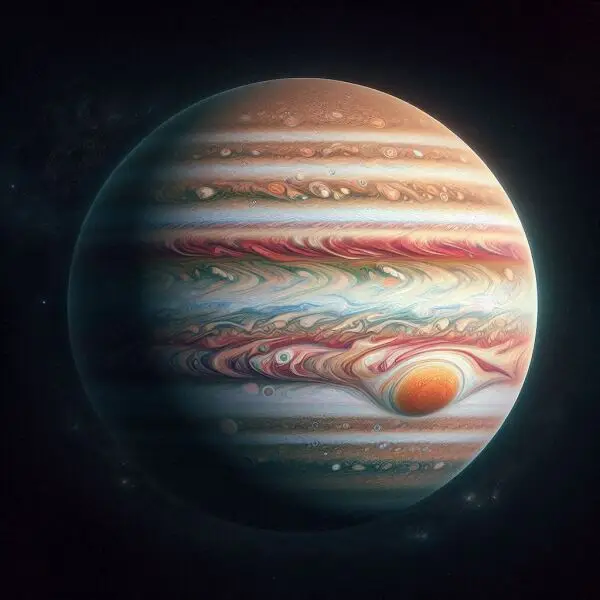The Great Red Spot of Jupiter is shrinking and we already know why
Discover the incredible cosmic storm that we have observed for decades on Jupiter. We unravel the mystery of its contraction. Explore the cosmos with us!...
Recently, interest in Jupiter and its iconic Great Red Spot has been revived.
This impressive phenomenon, which stands out as one of the most prominent objects in the solar system, has surprised scientists for decades, especially due to its remarkable contraction. But what is behind this reduction in size?
The Great Red Spot is a vast anticyclonic storm located in Jupiter's southern hemisphere, famous for its intense red color and enormous dimensions. At its peak, this storm was so extensive that it could accommodate several Earth-sized planets, with winds reaching speeds of up to 680 km/h counterclockwise.
The Great Red Spot is a vast anticyclonic storm located in Jupiter's southern hemisphere, famous for its intense red color and enormous dimensions. At its peak, this storm was so extensive that it could accommodate several Earth-sized planets, with winds reaching speeds of up to 680 km/h counterclockwise.
However, since its first observation in 1831, it has been shrinking, and recent measurements suggest that its current size is only one third of what it was in the past.
I suggest reading: The influence of planets in our lives
Now, a new study led by a team of researchers has provided crucial insights into this phenomenon. The key seems to lie in the interaction of the Great Red Spot with smaller storms.
I suggest reading: The influence of planets in our lives
Now, a new study led by a team of researchers has provided crucial insights into this phenomenon. The key seems to lie in the interaction of the Great Red Spot with smaller storms.
According to researcher Caleb Keaveney from Yale University, the larger storm feeds off these smaller storms; without them, its ability to maintain its vast size is compromised.
Scientists have used numerical simulations to demonstrate that the merging of these storms can directly influence the dimensions of the Great Red Spot.
Historically, in the late 19th century, the Great Red Spot was up to 39,000 kilometers wide.
Historically, in the late 19th century, the Great Red Spot was up to 39,000 kilometers wide.
In contrast, its current size is approximately 14,000 kilometers. Although it is still large enough to accommodate the Earth, its reduction is notable and unprecedented.
One of the greatest challenges in studying this phenomenon is the nature of Jupiter itself, whose atmospheric conditions are drastically different from those on Earth.
One of the greatest challenges in studying this phenomenon is the nature of Jupiter itself, whose atmospheric conditions are drastically different from those on Earth.
Nevertheless, researchers have applied principles of fluid dynamics that pertain to gases in the Earth's atmosphere to model the behavior of Jupiter's atmosphere.
Through this approach, they found that jet streams on Earth can give rise to high-pressure systems called heat domes, which can influence weather phenomena such as heat waves and droughts.
The study also suggests that the longevity of these domes may be related to the interaction of anticyclones and other storms.
The study also suggests that the longevity of these domes may be related to the interaction of anticyclones and other storms.
By applying these concepts to Jupiter, the team discovered that the smaller storms that encounter the Great Red Spot can maintain its size or even grow, which in turn helps stabilize the Great Spot.
However, the findings also lead to an inevitable conclusion: there is no possible intervention to save the Great Red Spot from its inexorable contraction.
However, the findings also lead to an inevitable conclusion: there is no possible intervention to save the Great Red Spot from its inexorable contraction.
Researchers emphasize that, although its disappearance is inevitable, studying this phenomenon offers valuable lessons about atmospheric dynamics that could be applied to our own planet.
Subscribe to the free weekly horoscope
Aquarius Aries Cancer Capricorn Gemini Leo Libra Pisces Sagittarius Scorpio Taurus Virgo
I am Patricia Alegsa
I have been writing horoscope and self-help articles professionally for over 20 years.
Subscribe to the free weekly horoscope
Receive weekly in your email the horoscope and our new articles on love, family, work, dreams and more news. We do NOT send spam.
Astral and numerological analysis
-
 Discover your future, secret personality traits and how to improve in love, business and life in general
Discover your future, secret personality traits and how to improve in love, business and life in general
-
 Online Dream Interpreter: with artificial intelligence
Do you want to know what a dream you had means? Discover the power of understanding your dreams with our advanced online dream interpreter using artificial intelligence that responds to you in seconds.
Online Dream Interpreter: with artificial intelligence
Do you want to know what a dream you had means? Discover the power of understanding your dreams with our advanced online dream interpreter using artificial intelligence that responds to you in seconds.

















